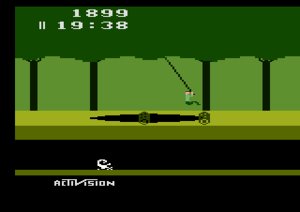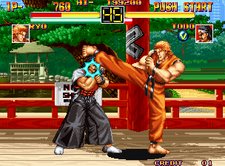The first blog that I wrote was a review on a game that I was playing at the time. This review was not a normal review, because I had to talk about the different game mechanics which make up the game. I then looked back into the past to look at game which also had the same type of game mechanics, so I could see where my chosen game had got its ideas from.
For my second blog, I wrote a detailed blog about one of the past games (Elite) that I spoke briefly about in my first blog. I had to do a lot of research into its development and the people who developed it.
My third blog was another research assignment, where I had to write about a game design studio. I looked at how it started out and where it is today.
The forth blog was an interesting one. It was about the controversial topic of computer game violence and the effects that it has on people. I had to watch a video called ‘First Person Shooter’. Once I had watched this I decided to write my blog about the research that has gone into the effect of violent games. After lots of research I got down to writing the blog. I would have to say that this was probably the most enjoyable blog that I wrote because, I have a lot of views on this subject, and so I was able to express my views in this blog.
For the next blog I was looking at game mechanics, but this time I would be looking at them at a deeper level. I looked at a review and pointed out the verbs, nouns and the rules that are in the review. This process allowed me to identify the key aspects of games design by linking the nouns and verbs together.
The sixth blog was more of a class activity; I say this because we had to decide a first person shooter to write a blog about, this blog would then go into a first person shooter family tree. It was another research assignment, where I had to decide a first person shooter no one else had chosen and then write about the game. I wrote about what the games about, the history behind it. I chose the game Delta Force: Black Hawk Down, this game is part of the Delta Force series so I wrote a little about the past games. I then wrote about the companies that developed and published the game.
The next blog was a very interesting one, I had to look at early Japanese games and American and European games and look at the difference between them especially the design aspect of these early games that were being developed in these different countries. I looked at the American Atari 2600 and the Japanese Neo Geo. I did research for this by choosing some of the well known games for each and playing these games, I then wrote about games and the differences of design between them.
For blog number 8 I had to write about different the business models from the early games industry. I had to watch a video called ‘The History of Video Games’. I talked about Atari and how they first started out, the way the games industry started out in Britain with its Bedroom designers and programmers I then finally looked at Nintendo.
The final blog was about MUDs, MUSHs, MOOs, and MMORPGs. This required me to do a lot of research, because I’m not the biggest fan of any form of RPGs. After a lot of research I talked about what each of the above is, I then looked at how MUDs have evolved into the MMORPGs that we have today.
So what have I learned from all this? Quite a lot actually. From the first blog where I had to talk about all the different game mechanics, I had never really thought about all the different types of game mechanics that there are in game (and there are a lot) and also looking back to other games that shared the game mechanics, so I could see where the games of today are thought up from. For the second blog, I learned a lot form writing about the development of the game Elite, from how it was made and who made it. I learned a lot from the research assignments, the third blog where I wrote about Rockstar. Rockstar make games that I play and enjoy so researching them and writing about them was very interesting. The blog I wrote about Computer Game Violence was I feel my best work, I had to do a lot of research and I learned a lot about some of the research that has been conducted into this subject. The next blog I feel was very interesting, I had to write about a review by picking out all the nouns, verbs and the rules of the game review. I learned a lot from this and found it a very interesting way of finding out all the game mechanics that exist in a game. I will hopefully remember this technique for helping me in games development. I learned a lot from the research that I carried out for the blog about games development in early American/European and Japanese game. I was surprised about the difference between them. While American/European developers were too busy ripping each other off by copying each others work, the Japanese were coming up with new ideas and making vibrant games (Although there were a lot of Beat – em – Ups!!! ). The blog about the business models was interesting. I learnt about the three different business models from different countries. The way Atari was set up and how well it was doing until it was sold and then all it problems started because the company that brought them tried to squeeze as mush money out of them as possible. As the games industry was crashing in America, in Britain bedroom designers and programmers were helping bring it back to its feet, and in Japan, Nintendo, who used to make game cards decided to make games as it saw that the games industry was proving to be a successful business to be in. I also learnt a lot from the last blog, I never even knew what I MUD was. All in all I have learnt a lot and enjoyed this module. I feel it has expanded my gaming knowledge, I have also been playing a lot of older games. I am also playing more games which I don’t normally play, e.g. I now play some RPGs even though I still don’t like them, but I know over time it will help my understanding of all types of game design.
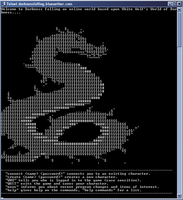
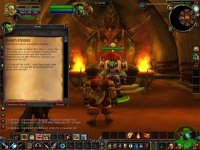

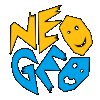
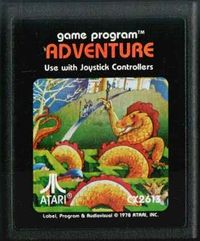 Adventure was, when first released, considered the first action adventure. It was released in1978 by Atari. Adventure was inspired by a computer text games called Colossal Cave Adventure. Atari bosses said that it could not be done but game designer Warren Robinett, created a graphic game based on a text game. Adventure went on to sell a million copies. The object of the game was to find the Chalice and return it too the Gold Castle. The character was represented by a square and would explore a multi screen landscape, which could contain castles, mazes and other various rooms.
Adventure was, when first released, considered the first action adventure. It was released in1978 by Atari. Adventure was inspired by a computer text games called Colossal Cave Adventure. Atari bosses said that it could not be done but game designer Warren Robinett, created a graphic game based on a text game. Adventure went on to sell a million copies. The object of the game was to find the Chalice and return it too the Gold Castle. The character was represented by a square and would explore a multi screen landscape, which could contain castles, mazes and other various rooms.